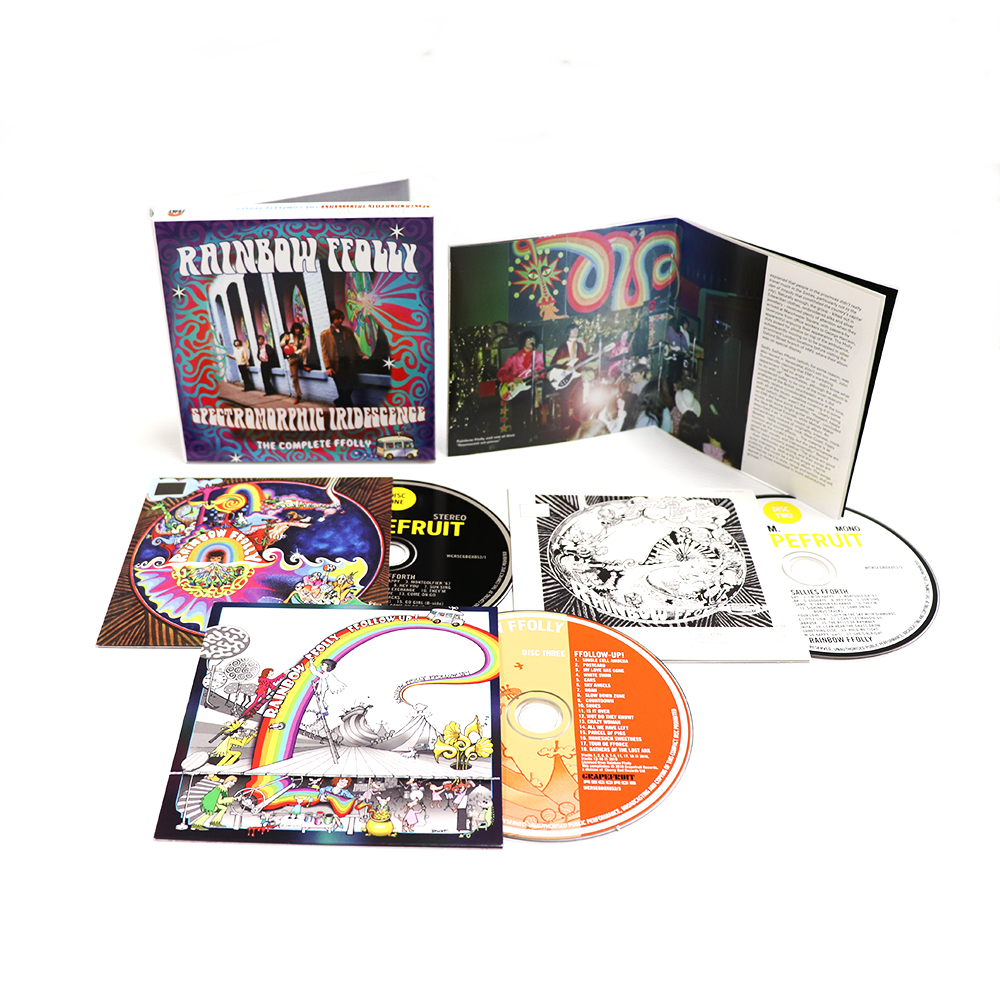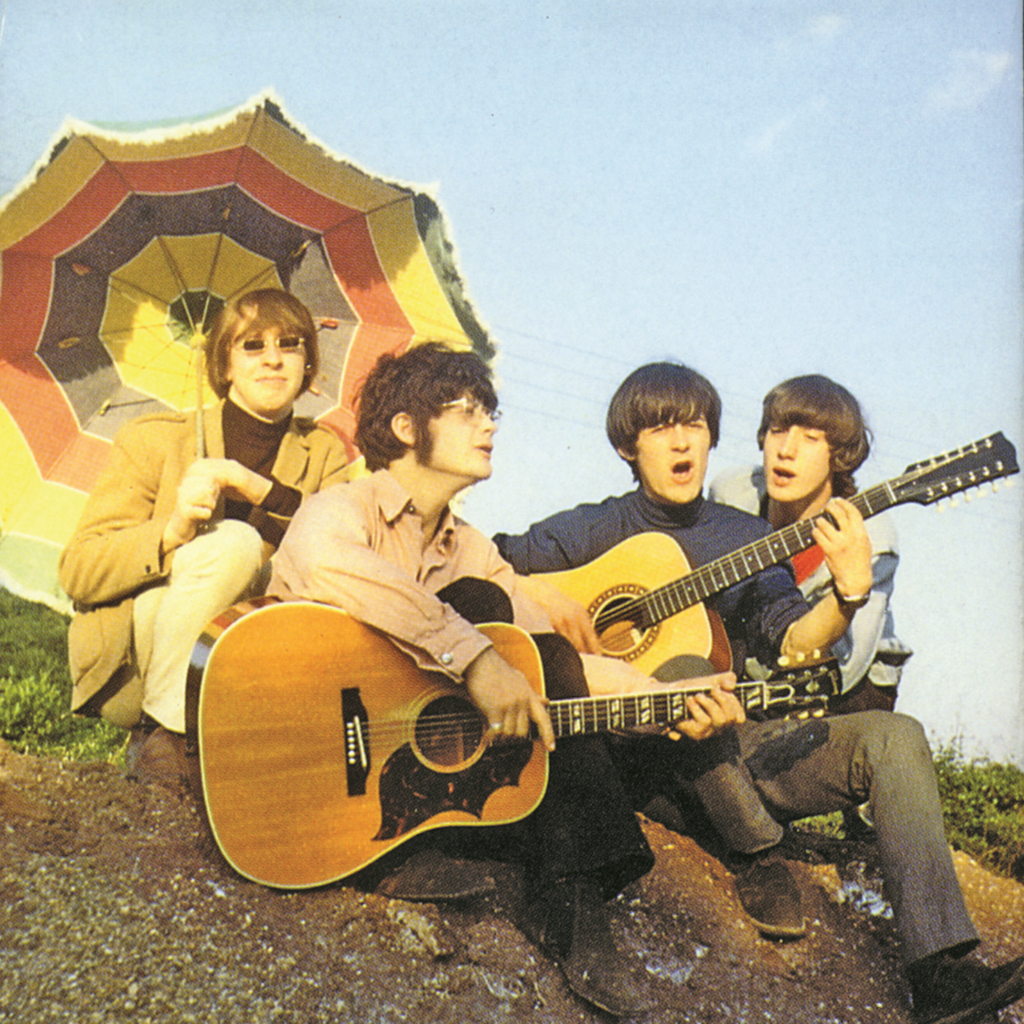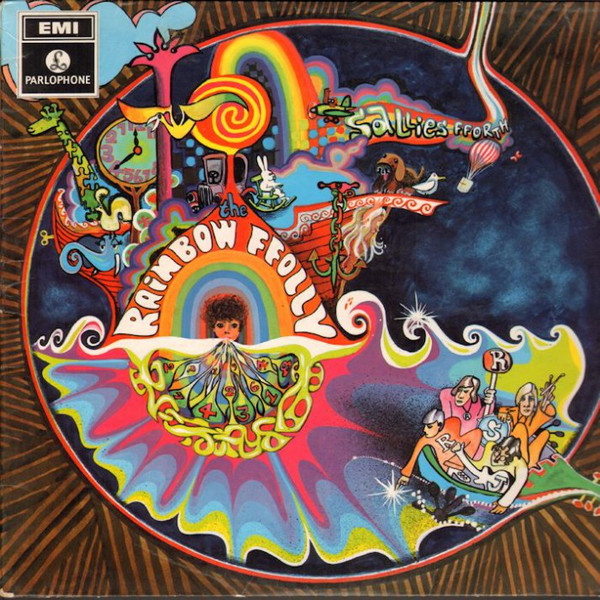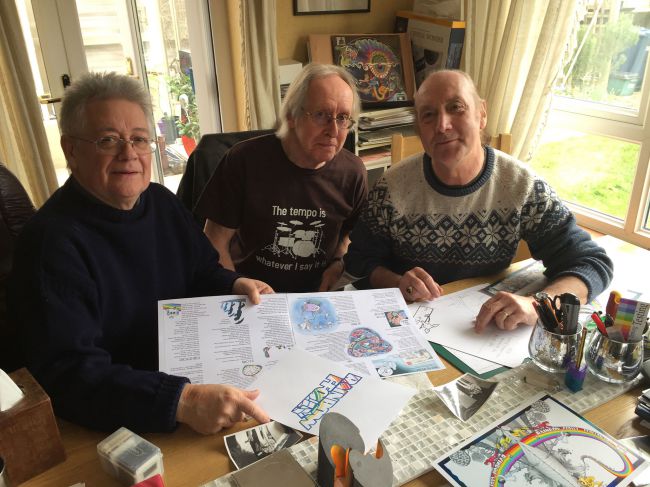Sallies Fforth by Rainbow Ffolly is one of the jewels of the British psychedelic era. A collection of demo recordings released by Parlophone in May 1968 it’s an album oddity for a major label, its lo-fi nature overcome by the its creativity. Jason Barnard speaks to Jonathan Dunsterville, guitar and vocals in Rainbow Ffolly, as Cherry Red releases ‘Spectromorphic Iridescence – The Complete Ffolly box set‘.
Hi John, let’s start at the beginning. Both you and your brother Richard were in the group. Do you come from a particularly musical family? Did you pick up the guitar from an early age?
I was youngest of five boys, my dad a schoolteacher and mum a Chilean (they met teaching in Antofasgasta Chile before the war. Both could play piano to a reasonable standard in light classical and show tunes (Jerome Kern et al.) I found a ukulele in a friend’s loft at age ten and learnt to play it to performance on local stage at eleven. The popular song sheets at the time had uke chord symbols with surprisingly sophisticated chords like F7b5 and Augmented7th, diminished etc. which opened my ears to more than 3 chords only. I was also in the local choir. My brothers were into trad jazz and inventing things – radios and record players were always on the go.
I understand that Rainbow Ffolly were originally called Force Four. Can you tell more about the early days of the group, it’s members and the evolution into the final Rainbow Ffolly line-up?
By 14 a local dance band / pop group invited me to play guitar and got me an amp – by then I had a Hofner Committee guitar (much sought after now). The band became Val and the Moonrakers (still see Val from time to time) playing for dances and parties. Line-up was Tony Bates (drm) Dave Pearce (bass) and Val – vocals. Everleys and Brenda Lee stuff. I left to start own group Force Four with Stewart Osborn and Brother Richard and Alan Thomas on Bass who eventually left and a young Roger Newell jumped in. The music was eclectic ranging from rock to early soul. Playing for local clubs and then Johnny Sparrowhawk of A1 Entertainments found us and started pushing us. We purchased an old ambulance (and put a key on top) and started to do more gigs around South and West. Jacksons was an obvious choice of local studio but in the meantime Stewart set up a music room above his Mum’s shop in High Wycombe, complete with Ferrograph Tape recorder and some ancilliaries. By now I had left the Royal Grammar School in Wycombe and was at Art school. I always designed cards and album covers mainly for fun as I was into graphic art. After we had recorded a bit with John and Malcolm Jackson we needed a more hip name. Hence Rainbow FFolly was properly formed.
What was the music scene like in Buckinghamshire in the mid-60s?
Early bands had Jimmy Mac and the Beatfinders (who I used to bunk off school to watch rehearsing in The Flint Cottage pub in Wycombe) They had two really tall guys – Roger Sandilands who played an early Gretsch Duo Jet and Peter Robinson Singer in the Elvis style (later to play an important part in the music of Wycombe. In the early 60s however, there were groups like The Technics, Trampoline and Duo Shirley and Johnny. We all played local clubs and occasionally the American Air Base in Wycombe as well as Naphill Bomber Command Officers Mess. The Technics morphed into The Switch which was where Roger cut his teeth as bass player.
What was your typical live set list prior to recording your own material – was it principally covers?
We soon realised we had a good harmony going on so Jan & Dean, Beach Boys, Four Seasons, Coasters and more soul stuff like Brenton Wood and Ketty Lester. Of course, all bands played versions of The Who, Stones, The Move, Small Faces, Kinks and later Hendrix and Cream. We could also play strict tempo dance stuff of the day – waltzes and Quicksteps and Foxtrot, mostly in my Chet Atkins style. (as for the Shadows – we did a few and also the Beatles grittier numbers like Twist and Shout.)
The new box set features the early demos for ‘Sun Sing’ and ‘Come On Go’ in April/May 1967. Whose idea was it to record demos and what was it like recording in a studio for the first time?
The original idea was to write some of my own stuff and Stewart did the early demos at his Mum’s place. Johnny Sparrowhawk took the demo to the Jacksons. They gave us a few hours in the studio – but we were not nervous although very green. Johnny got us going, he loved harmony work in Jazz outfits like The Hi-Los and George Shearing, and was a good singer and had done the Richmond Cigarette ads for Radio Luxembourg. He soon got hip to our new ways you could say.
What are your memories of writing and recording those tracks that were released as Sallies Forth?
After the initial demo Malcolm and John wanted us to write 10 more songs in different styles to find out what our capabilities were. I came up with 8 songs in the next two weeks ranging from folksy to whimsey, Jazzy to outright Pop with some psychedelic experiments thrown in. Roger also co- wrote but the whole group chipped in with arrangements and ideas. A real hive of activity. We all loved odd instruments and tried to create percussion instruments and strange tunings, banjos mandolins, celeste and piano. I was playing a bit of keyboards including an old Farfisa organ. Jackson bros recorded us in their down-time. We started to assist in mixing the tracks but were surprised to find they had sold the demo in its entirety. The same as with the Beatles stage gigs, there was no way to put these diverse sounds into our pop/rock set on our gigs.
There’s so many great ideas bursting out of each track, plus there’s linking jingles and sound effects. This is something The Who were doing in parallel to you with The Who Sell Out. Am I right to assume you were given the space and time to be creative?
One great thing the Jacksons did was to allow experiments – after all it was their dad Jack Jackson who created an entirely new format for disc jockey radio shows. I sang through pipes and tubes. In boxes and reversing and splicing tapes. At that time the Local Hospital needed songs and jingles over a weekend and we rushed them through on Stewarts gear which is why they sound a bit tatty! We jumped at any chance to record and rehearse. We were not thinking about any ‘sell out’ movement that the Who were into.
‘Drive My Car’ takes the title of a Beatles song but creatives something completely different. Was that something you did on purpose?
I really can’t remember how this one came about but all bands played songs about cars from Bo Diddley’s Roadrunner to Maybelline and Fun Fun Fun etc. I seem to remember calling it I’m Drivin’ my Car – no attempt to ride in the Beatles Creation whatsoever! (theirs was sooo good anyway)
What other records were you listening to at the time and which ones do you feel most influenced those sessions?
Interesting question this one, I loved early blues (Broonzey, Sonny Terry & Brownie McGhee and Jessie Fuller) Early soul Ketty Lester’s sexy Love Letters, Julie London’s Cry me a River. Sam Cook’s Wonderful World and Ruby and the Romantics. All of Brit Pop stuff with grit in it. A great favourite was John Sebastion of the Spoonful. But for me the greatest influence was the art and fashion that was going on at the time with Happenings and Quirky clothes and op art from Bridget Riley and Mary Quant stuff. Light shows and visiting bands from USA spiced our lives up. For me – Hums of the Spoonful was never far from my turntable.
My song Goodbye was written on the back of Ruby and the Romantics Our day will Come. I began to work out my own version of slash chords (E over A and G over A) there’s a bit of that in Goodbye. I listened a lot to Chet Atkins and the ever-wonderful Merle Travis – styles I had down at a tender age. They’m in the style of Flying Purple People Eaters and Spoonful’s Henry Thomas. I liked and still do, Dave Berry’s Crying Game with Big Jim Sullivan’s beautiful De-Armond pedal Gretsch solo (to die for) and armed with just a title of ‘The Sighing Game’ came up with the song to suit. Even now if someone gives me a clue, I turn it into a lyric or a tune in my head which is why I hate piped music in restaurants and hotels because I cannot stop my brain working out chords and analysing what I hear.
You renamed the group Rainbow Ffolly, which seems more fitting for psychedelic era. Where did you get the name from?
Wally Fawkes’ Daily Mail Cartoon Strip, Rufus and Flook was so beautifully and cleverly illustrated. I collected them and just loved the characters. There was an Establishment figure in Rufus and Flook with the name Sir Montague Ffolly. Rainbows were much the order of the day, but I thought the whole thing was financially sheer folly and so Rainbow Ffolly came about. Wrong spelling in names were abundant at the time. I used to say to some that my name was Jonathan spelled with a silent 5! My family loved Tom Lehrer and his biting humour, and he disliked as do we, pompous pseuds. In my mind it was a gentle satire on pop names. Careful with the psychedelic tag – we were into op and colourful art of the London Scene, while American psychedelia is drug related (LSD) and has distorted swirling colours and childish eyeballs etc – not our bag at all. All our band much preferred to be thought of as eccentric Englishmen – who else would have a 4-foot six cut-out of Rupert Bear on stage and an ambulance with a key on top. I am also reminded of putting on a kettle (with whistling lid) a number before the end of the first half and as soon as the whistle blew, we stopped for a tea break.
It seems remarkable that the Jackson brothers, who run the Jackson Recording Studio, got a deal to release Sallies Forth untouched. I assume that was a huge surprise? Was it a mixed blessing, would you have preferred to re-record the material at Abbey Road?
Oh yes! It was, and we would! We could have improved and put out more danceable songs if we were given the chance then it would not have stifled our gigging potential. Also, we needed a cool-off period to evaluate and start to get rid of those embarrassing bits! I suspect that it was not financially viable to record at Abbey Road anyway. (We have all recorded there many times since.)
You also designed the Sallies Forth album sleeve. Did you have a clear vision for this from the outset and were there any alternative sleeves proposed?
I like the whimsical approach, but I assure you that when I had to design the sleeve, I treated it as a project and did proper research. I spent two whole days in local record shops finger-flipping through the sleeves to see what stood out. Pictures of oiks or scantily clad chicks were everywhere as were photos or rather irrelevant art which I had the temerity to assume was not appealing and frankly old hat and boring. Good colour was needed which is why I came up with a sort of magnifying glass (brown outside light inside) Sallies Fforth suggested a boat with us in it moving out towards the observer leaving a jumble of whimsical cartoon animals and the Ark (an image that appears in my artwork often) Drawing the eye into this scene is like a stage prop. The reverse of the sleeve should have lined up with the front so the one could see that it was a façade. Jane my good wife did some expert drawing and bits of gouache work as well as linework on the back. Second attempt and we got it about right.
Same as designing the Ffollow Up sleeve (which had its origins of a landscape with distorted perspective connecting various images over a staged and planked floor with all the workings below) Jane and I had fun designing and doing this one. Interesting to note that when I was asked by EMI what cover I had thought of for the next album I replied ‘A white One’ – nothing on it at all but the edge and inner sleeve would pull out to show a rainbow in an arc. A good year before the Beatles came up with that one!
Sallies Forth received positive reviews on its release, with ‘Drive My Car’ released as a single. However, neither charted. Do you feel you got sufficient support from EMI?
Another good question. Had EMI got to know us properly then maybe things might have been different, as it was, we were assigned a couple of hours in their offices with a young bloke and a cameraman. Fault should not be apportioned to anyone – perhaps we were all caught off guard!
What were your gigs like at the time, did you play the album live by now? Where you headlining shows by now and do you have any particularly memorable live moments?
As it was difficult to stage a Rainbow FFolly show with lights and dancing girls, and not having enough funds to go the extra we all needed, we only slipped a few of the album set in. The Playboy residency was fun as the Star Club Hamburg was grim. London clubs were very responsive. I remember at the Whisky a Gogo or was it the Flamingo where we had taken the gamers off the roulette wheels to watch our show – much to the annoyance of the manager. We did shows in the cinemas and the odd festival. We went down better than the Marmalade in The Electric Garden in Glasgow at the time of ‘Ob-La-Di, Ob-La-Da’ and giving the early Moody Blues a real worry (both later to return and stamp all over us!!) We were a tough wiry bunch with our infernal unstoppable optimism however and enjoyed sets with Jeff Beck Band and Geno Washington.
In late 1968, you recorded a great cover of ‘The Continuing Story of Bungalow Bill’ as a potential single. Was that a conscious decision to get more commercial success given other groups were having hits by covering The Beatles?
This was a Jackson’s idea – not something we were totally committed to doing. The recording technique was getting better though, and the quirky humour appealed to us.
The second disc of the set also has music sessions that the group recorded for Radio 1 and includes versions of ‘Sunshine of My Love’, ‘I Can’t Let Maggie Go’ and ‘I Can Hear the Grass Grow’. Were the tracks you covered ones you played live at the time?
Yes, we played these songs in our set. The recording session was in the morning and we really knocked them through singing and playing at the same time much to the surprise of the engineers. The reason being that we had a gig in the west country that very evening.
Were you writing material to follow up Sallies Forth and why didn’t you release any further material in that period?
We could not afford to add to our catalogue and although we carried on a short while with new song ideas on Stewart’s gear, we had decided to call it a day. Many song ideas and art sketches were produced but shelved.
Why did the group split in late 1969?
While the rest of the group were living at home, Jane and I were living in a flat costing £10 a week and there was one time I only brought home 10 shillings. Jane and I started our Glass Fibre company Freeform, manufacturing parts for model plane kits and later motor home elevating roofs. Roger and Stewart wanted something heavier musically. Richard joined us in our company and married light show specialist American Theresa Rice who could make more money doing lights for local bands.
 Can you tell me what you afterwards professionally and musically?
Can you tell me what you afterwards professionally and musically?
To keep my hand in I joined an old fashioned Dance Band. Leader Ted Chapman was an ex RAF saxophonist playing the American songbook and of course Glenn Miller dance tunes. Roger and Stewart formed a tough group called Bad Wax with guitarist Roger Bates and soul singer Ashley Holt. Richard went off to Austin Texas with Terry. Now I made loads of GRP mouldings and made enough money to start a family. I also did lots of travel agency aeroplanes (Tridents, 747s and Concorde) and was getting into film prop work as well.
How did you get to play with Rick Wakeman?
Roger Newell with Ashley Holt used to have jam nights at The Valiant Trooper in Holmer Green High Wycombe and Rick used to enjoy sitting in (to get away from the strictures of Topographic Oceans) Rick also used to play for Reading’s Top Rank’s resident group The Ronnie Smith Band and Ash was the singer.
Strangely enough I was asked by Pete Robinson (now a manager of Packhorse Flight Case Company) to make a sword in a stone prop and some stage accessories for Rick Wakeman and took them down to his warehouse/studio in the industrial side of High Wycombe. Rick was rehearsing with his band The English Rock Ensemble and Ashley and Roger (now in his band) said ‘audition for the show as we are desperate for a guitarist’. Not up to Steve Howe standard I nevertheless got the job only to find the 4th gig in, was Madison Square Gardens! Complete whirlwind of orchestras, roadies, planes, Cadillacs, recording and Stadium Extravaganzas ensued with us being spat out at the end of a couple of years. Rick going back off to Yes.
When did you find out that original vinyl copies of Sallies Forth were fetching high prices and had gained a cult following? What did you make of this?
It was a bit bizarre to say the least as each album was soon changing hands for more than we made in the first place. Roger kept more in the business being in the band Trux, and also doing reviews for Bassist and Guitar Magazines, and it was he who kept us informed. Collectors would be calling up to see if we had any spare albums and acetates hiding in the loft, so we had a feeling something was up!
Had you kept in touch with Roger and Stuart over the years?
All four of us kept in touch although Richard went off to Nevada and became a gold miner while Terry his wife became a mermaid and taught pigs to swim for a living. (Now there’s a story and a half – true as well – could only happen in the States!) Roger Stewart and I played from time to time in a little nightclub but nothing serious. We were always real good friends and still are.
Rainbow FFolly, 2016, left to Right: John Dunsterville, Stewart Osborn and Roger Newell (photo from loudersound.com)
Was re-convening the band a few years ago and recording Follow Up! a chance to settle unfinished business?
Having learnt to record digitally and believing it not to be the sole domain of the young, we realised that there were quite a few really good un-recorded songs that needed some revisiting. It seriously was just as yesterday – the humour, quirkiness and being so in tune with one another. We can get through the bit where someone is talking bollocks and we work on the many positives we do have. It gave us a chance to see if we could do this ourselves.
‘Sky Angels’ and ‘Noah’ are tracks that particularly work well on Follow Up!. When does the songs on that album date from?
‘Noah’ was written in 1968 and would have appeared with My love has Gone on the next album. Sky Angels and Nonesuch Sweetness were written in 1976 for English Rock Ensemble.
I’ve heard that you’re working on a third Rainbow Ffolly record. Are you able to share any further details about it?
Yes – we carry on developing our ideas. Some are simple offerings others are more extravagant. We can’t seem to write in any one style, but there again why should we. Having written music for a short film and Country Bands and arranged music for vocal harmony groups and Roger in a heavy metal outfit and treading the boards with legend Marty Wilde, we have a wide range of material. I am constantly writing lyrics and music and expanding my instrument playing and see no reason to stop.
Looking back, which tracks from this box set are you most fond of and why?
The perky ideas on Sallies FForth still get through – just. I love Sun Sing, Sighing Game, Montgolphier and particularly Goodbye which is a sophisticated piece of work for an untrained muso.
Roger is fond of Is It Over – having created a great atmosphere and the reverse guitar is haunting and one of my best. Cars was written on endless freeways in the States and Canada and though with Joni Mitchellesque rhythm has a good nimble solo and typical Ffolly chord twist at the end. I still listen with delight to Slow Down Zone which someone said why play 3 chords when 300 will do?! The harmonies are special and little Roselle’s top harmony line is a sheer delight. But we all like the story and originality of White Swan. Tops for the three of us is the track Sky Angels. Quite an opus – indeed one of my chums asked if it came with an interval – cheeky sod! Originally the trumpet in the solo was done by Martin Shields of the English Rock ensemble but for the new recording we needed two trumpets one a piccolo one. Martin was a superb player and was in Maynard Ferguson’s Band. We had no idea how bloody good he was until we tried to re-create the solo he ‘knocked’ out. Noah captures for us the sound of the original Ffolly when Richard used to get that electric 12 string pushing through like a peal of bells.
Happy days are here again! Even though music today is too abused, and download is considered the norm and is therefore the property of the listener, it is still wonderful to have the creative opportunity to set things right and look forward to the next bunch of Ffollysongs.
Thanks so much for your time John and for sharing your memories of the last 50 years. All the best for the release of the new box set and the next Rainbow Ffolly album.
Rainbow Ffolly: Spectromorphic Iridescence – The Complete Ffolly, 3CD Clamshell box set is released by Cherry Red on January 25, 2019
Further information can also be found at rainbowffolly.com






